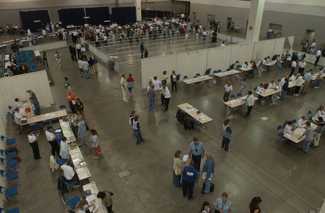Community-Wide (Mass) Vaccination
This strategy vaccinates all eligible and willing people in an area. If there are not enough personnel to trace and vaccinate all contacts quickly enough, public health authorities may choose to implement community-wide, or mass, vaccination campaigns in addition to the ring vaccination strategy. Local public health departments will be responsible for standing up smallpox vaccination clinics in this strategy. Even if mass vaccination campaigns have begun, public health officials should continue ring vaccination to make sure those who have been, or may have been, exposed to a smallpox patient receive the vaccine within a timeframe that will reduce their chances of contracting the disease.
Use existing plans for Points of Dispensing (POD) for other emergencies as a starting point for developing smallpox-specific mass vaccination plans. If you need more information on PODs, refer to the webinar, Mass Dispensing Overview: An SNS Perspective, available online at TRAIN. This hour-long course goes through the necessary details to include in a POD plan.

Public health workers setting up a mass vaccination clinic.
Emergency plans should address the following points where smallpox vaccination clinics will differ from PODs:
- PODs are designed to dispense medication to the public as quickly as possible. Some plans may allow for head of household pickup or even drive-through dispensing. A smallpox vaccination clinic will require each vaccinee to come to a specific location. The increase in headcount may require additional clinic locations, additional hours of service, or larger locations. All of these changes will affect the number of staff required.
- In addition to the regular staff required for a POD, a smallpox vaccination clinic will require more medically trained staff who will:
- Screen vaccinees for contraindications
- Assess vaccinees for which vaccine they should receive (if different vaccines are available)
- Administer the vaccine
- Educate the vaccinee on proper vaccination site care (for those receiving ACAM2000® or APSV) or how to decrease the risk of exposure to smallpox before developing immunity (for those receiving Imvamune).
- The different vaccines may be shipped at different temperatures (either frozen or refrigerated) and may require separate storage facilities to maintain the cold chain. Work with local and state immunization teams and use existing plans for cold chain management.
- Determine ways to protect vaccinee privacy when screening for which vaccine to use. Consider ways to include private screening areas in the clinic layout. In a smallpox emergency, Imvamune would be made available for use under an Emergency Use Authorization (EUA) and according to clinical recommendations for persons of all ages with atopic dermatitis or certain immune deficiencies, such as HIV. Avoid situations which single out or draw attention to vaccinees who are receiving Imvamune rather than ACAM2000® or APSV and ensure proper safeguarding of all vaccinees’ confidential health information and personal identifying information.
- All vaccine-related waste from a smallpox clinic is classified as Category B hazardous waste. Verify plans for disposal and transport meet local, state, and federal requirements. Educate all clinic staff to follow these guidelines.
Modeling Staffing Requirements
Two software programs may help plan a smallpox vaccination clinic by modeling different staffing and patient volume options:
- Maxi-Vac Simulation Software – Developed by CDC, Maxi-Vac 1.0 and Maxi-Vac Alternative are programs state and local public health officials can use to plan large-scale smallpox vaccination clinics with maximum patient flow-through.
- RealOpt – A program to model mass dispensing and mass vaccination efforts during a pandemic, bioterrorism attack, or radiological disaster. This free program is available for public health or emergency management professionals. RealOpt training is available on TRAIN.
Resource
- Mass Dispensing Overview: An SNS Perspective – Self-guided, online training course offered through TRAIN (Course ID: 1054681). Note: This content focuses mainly on how to prepare for and run a Point of Dispensing site for medical countermeasures, which includes vaccines.
- Page last reviewed: January 6, 2017
- Page last updated: January 6, 2017
- Content source:


 ShareCompartir
ShareCompartir